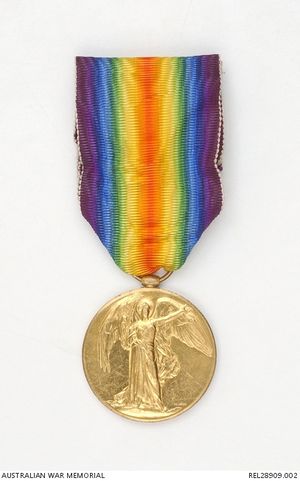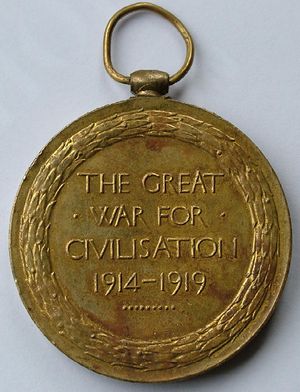Difference between revisions of "Victory Medal"
From Our Contribution
(→Awarded to:) |
|||
| (2 intermediate revisions by the same user not shown) | |||
| Line 3: | Line 3: | ||
==Eligibility== | ==Eligibility== | ||
| − | The Victory Medal was issued to all those who had already qualified for the 1914 Star or the 1914-15 Star, and to most persons who had already qualified for the British War Medal. Those who only served in Great Britain were not eligible, although those serving only in Egypt were. | + | The Victory Medal was issued to all those who had already qualified for the 1914 Star or the 1914-15 Star, and to most persons who had already qualified for the British War Medal. The requirement was for them to have entered a theatre of war. All three armed forces were eligible. |
| + | |||
| + | Those who only served in Great Britain were not eligible, although those serving only in Egypt were as it was declared to be a theatre of war. | ||
==Description== | ==Description== | ||
| + | The medal is struck in bronze. | ||
| + | |||
| + | The obverse of the medal depicts the standing figure of Victory holding a palm branch in her right hand and stretching out her left hand. On the reverse of the medal is a laurel wreath containing a four-line inscription: "THE GREAT WAR FOR CIVILISATION 1914-1919". The dates are '1914-1919' to include post-war intervention by the Allied nations in the Russian Civil War. The medal is yellow bronze and is attached to the ribbon by a ring. | ||
| + | |||
The Victory Medal is distinguished by its unique ‘double rainbow' ribbon. Approximately 6 million of these medals were issued to military personnel from the British Empire. | The Victory Medal is distinguished by its unique ‘double rainbow' ribbon. Approximately 6 million of these medals were issued to military personnel from the British Empire. | ||
Individuals who were Mentioned in Despatches wear a small bronze oak leaf on this ribbon. | Individuals who were Mentioned in Despatches wear a small bronze oak leaf on this ribbon. | ||
| − | + | This medal is sometimes referred to as the "Allied War Medal", because the same basic design and the double rainbow ribbon were adopted by 13 other Allied nations. | |
| − | + | The soldier's regiment and number are inscribed around the rim of the medal. | |
==Awarded to:== | ==Awarded to:== | ||
| − | With very few exceptions, all those who went overseas. The exceptions being UK based forces only and those convicted of significant offences. | + | With very few exceptions, all those who went overseas. The exceptions being UK based forces only and those convicted of significant offences. (The Victory Medal was awarded to prescribed classes of persons who entered a theatre of war on duty between 5 August 1914 and 11 November 1918.) |
| + | |||
| + | 5,725,000 medals were issued. | ||
[[Category:Medals]] | [[Category:Medals]] | ||
Latest revision as of 14:37, 21 August 2018
Eligibility
The Victory Medal was issued to all those who had already qualified for the 1914 Star or the 1914-15 Star, and to most persons who had already qualified for the British War Medal. The requirement was for them to have entered a theatre of war. All three armed forces were eligible.
Those who only served in Great Britain were not eligible, although those serving only in Egypt were as it was declared to be a theatre of war.
Description
The medal is struck in bronze.
The obverse of the medal depicts the standing figure of Victory holding a palm branch in her right hand and stretching out her left hand. On the reverse of the medal is a laurel wreath containing a four-line inscription: "THE GREAT WAR FOR CIVILISATION 1914-1919". The dates are '1914-1919' to include post-war intervention by the Allied nations in the Russian Civil War. The medal is yellow bronze and is attached to the ribbon by a ring.
The Victory Medal is distinguished by its unique ‘double rainbow' ribbon. Approximately 6 million of these medals were issued to military personnel from the British Empire.
Individuals who were Mentioned in Despatches wear a small bronze oak leaf on this ribbon.
This medal is sometimes referred to as the "Allied War Medal", because the same basic design and the double rainbow ribbon were adopted by 13 other Allied nations.
The soldier's regiment and number are inscribed around the rim of the medal.
Awarded to:
With very few exceptions, all those who went overseas. The exceptions being UK based forces only and those convicted of significant offences. (The Victory Medal was awarded to prescribed classes of persons who entered a theatre of war on duty between 5 August 1914 and 11 November 1918.)
5,725,000 medals were issued.

